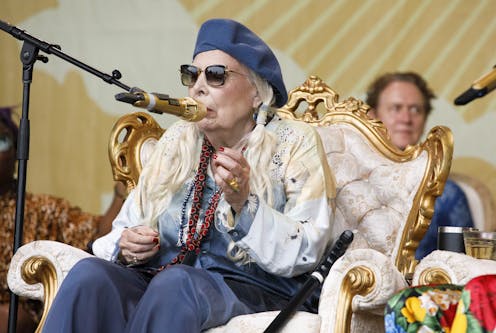
The iconic Joni Mitchell’s recent surprise performance at the 2022 Newport Folk Festival prompted a world-wide outpouring of love and respect.
This was her first musical performance since suffering from a brain aneurysm in 2015 that left her unable to walk and talk. Last year, she spoke of having polio as a child as “a rehearsal for the rest of my life”.
The tributes for Mitchell celebrated her triumph from illness to recovery, but they also paid homage to Mitchell’s career that has pivoted on protest.
Mitchell is largely associated with folk scenes of the 60s and 70s. She has produced a prolific body of work, advocating for social change. As a committed activist she has spoken against environmental degradation, war, LGBTQI+ discrimination, and most recently, removed her music catalogue from Spotify in a protest against anti-vaccine propaganda.
Now, with the strokes of a guitar solo she repositioned herself from folk hero to punk provocateur, defying the “permissible” ways older women “should” behave.
In commanding public space and using one of the most traditionally masculinised expressions of popular music practice, she directly challenged the sorts of expectations many people have around gendered norms, particularly what women in their elder years look and sound like.
Not everyone gets to age on stage
Some of the most persistent social restrictions placed on women and gender diverse musicians are in relation to age.
Ongoing expectations of older women are to be passive, quiet and very much in the background. They are rarely asked, or expected, to “take up space” in the same ways their male counterparts do.
Whereas men step through phases of youthful experimentation into established music legends, there are tiresome obstacles for female and gender diverse people to do the same.
And while exceptions are often exceptional, they are not plentiful.
It’s not just age. Women have long been sidelined when it comes to acknowledging their skills on the electric guitar. Much like Mitchell.
The electric guitar has been an important part of rock and punk genres. There is a symbiotic relationship between how these genres – and the instrumentation that defines them – have unwittingly become gendered. The electric guitar solo in particular has come to be associated with machismo: fast, loud, expert, brave.
If you like to imagine a world where women don’t exist, google “best guitar solos ever”.
A recent New York Times article suggested things are starting to change. Citing guitarists like Taja Cheek and Adrianne Lenker, the Times suggested the guitar solo has shifted from a macho institution into a display of vulnerability, a moment (perhaps many) of connectivity.
Mitchell’s performance sits somewhere in this domain.
For the hundreds of thousands of women and gender diverse guitarists world-wide, myself included, the electric guitar and the genres it is entwined with offer a cool, optional extra: to test the cultural norms of gender with other markers of identity like class, culture, sexuality and age, to blur ideas of what we should and shouldn’t do.
Read more: We crunched the numbers on ten recent ‘world’s best guitarist’ lists. Where are the women?
Australian women to the front
Australian women and gender diverse rock and punk musicians are often subject to a double act of erasure – missing from localised histories, and also from broader canons of contemporary music, which often remain persistently rooted in the traditions of the UK and the US.
Tracey Thorn’s brilliant biography of the Go-Between’s drummer Lindy Morrison is a love lettered homage that steps out the complex local, emotional, personal and structural ways that Australian women and gender diverse people are often omitted from cultural spaces.
“We are patronised and then we vanish,” writes Thorn.
The work of women and gender diverse artists is often compared to the glossy pedestal of the male creative genius.
In this light, we don’t play right, we don’t look right, we don’t sound right.
And then, somehow, we don’t age right.
Other reasons are far more mundane. Women contribute around 13 hours more unpaid work than men each week.
Carrying plates overflowing with generous gifts of labour, the maintenance of a music practice – a largely underpaid endeavour – is often the first to fall by the wayside.
Add to the mix ingrained social networks of knowledge sharing, and the dominance of men making decisions higher up the chain, and it is easy to see how women and gender diverse musicians stay submerged as men rise to the limited real estate of music elders.
The problem isn’t so much about starting up. It’s about finding the time to keep up.
Read more: Friday essay: punk's legacy, 40 years on
Our female and gender diverse music elders
There are so many Australian female and gender diverse music elders. Some are visible, but many ripple beneath the surface.
Regardless of genre, in maintaining decades-long practice, they are the super punks whose legacy can be heard in venues across the country.
The challenge now is to support the current crop of excellent musicians beyond the flushes of youth so that we have a more sustainable, textured and diverse Australian music culture. One where Mitchell’s defiance of expectations represents the status quo of how older women should and can be.
Read more: Her Sound, Her Story shows that women's voices are louder than ever in Australian music
Janelle K Johnstone has received funding from Creative Victoria and the Australia Council.
This article was originally published on The Conversation. Read the original article.







